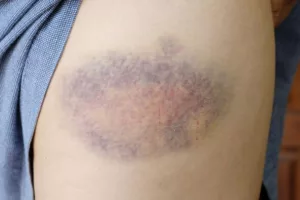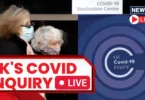To combat the illness, she went through three cycles of chemotherapy and received a bone marrow transplant.
A nurse, Jan Henry, hailing from Barrow-in-Furness in Cumbria, initially believed that marks on her tights were nothing more than regular blemishes. However, on her first day in a new job, she came to realize that these marks were, in fact, bruises. This revelation led to the distressing diagnosis of acute myeloid leukemia, an aggressive form of blood cancer.
Watch Video Here
According to a report from Bristol Live, Jan was serving as a senior sister in the same hospital where she had previously worked in the A&E department. It was during this time that she noticed an unusual occurrence on her legs.
She recounted, “While adjusting my tights and attempting to alleviate the peculiar sensation of fabric clinging to my skin, I tried to remove what I initially thought was stuck to them.”
Upon closer examination, it became apparent that the marks were actually purpuric bruises. Purpura refers to small blood spots that manifest beneath the skin, typically occurring when blood vessels leak under the skin.
Worried about the situation, Jan shared her concerns with one of her colleagues, a specialist nurse in rheumatology, who promptly arranged for her to consult with a specialist. During this assessment, it was discovered that she had an enlarged spleen, and she was subsequently scheduled for a blood test.
Jan expressed her shock at the subsequent events, saying, “What transpired next left me utterly astonished. It was highly likely that I had acute myeloid leukemia (AML), and my diagnosis was officially confirmed the following morning. Just like that, I was on my way to Manchester Hospital.”
“Even though I had a career as a nurse sister in the A&E department, I had never encountered leukemia before.”
Jan, who is now 66 years old, received the distressing news that she might not survive beyond the initial treatment. Recalling the moment, she said, “Upon arriving at the hospital, I had a candid and rather frightening yet optimistic conversation with the professor. My chances of surviving the first round of chemotherapy were only 50 percent.”
She continued, “My dear late husband, Dave, and I took a walk and sat on a bench, contemplating the seriousness of what we had just heard. It was a chilly, clear night, and we wondered if it might be the last time I would ever gaze upon a starry sky.”
The full gravity of the situation didn’t truly impact Jan until she was introduced to a Hickman line, a medical device that provides extended access to a patient’s veins for various purposes, including chemotherapy, intravenous medication, nutritional support, and blood sampling.
She reflected, “It was only when I saw the Hickman line for the first time that the harsh and startling reality of viewing myself as an ill individual began to register.”
Thankfully, the initial round of chemotherapy yielded positive results. Jan recalled, “I was determined to recover before my son’s birthday, and I succeeded. The chemotherapy led to my first remission, eliciting a collective sigh of relief.”
For her second round of chemotherapy, Jan was hospitalized, and she spent Christmas Day there, surrounded by her family. Following a brief return home, she was readmitted for a third round of treatment.
Subsequently, Jan underwent a bone marrow transplant, a procedure that medical professionals believed would enhance her chances of survival to 60 percent.
“I was fortunate that my sister, Gill, turned out to be a perfect match, and I received my bone marrow transplant,” she stated.
“Eleven months after my diagnosis, I was back at work. It took me five years to acknowledge that the persistent fatigue and lack of concentration had become overwhelming, and I opted for early retirement due to health issues. But here I am, at the age of 66, still alive and thriving.”
Jan expressed her deep gratitude to the NHS and her sister, emphasizing that her life was indebted to them. She even has two lily tattoos on her pelvis, symbolizing the sites of numerous bone marrow biopsies. She added, “Thank goodness for tights and being in the right place at the right time.”
Today, Jan is partnering with the charity Leukaemia Care to share her story and raise awareness about the symptoms of this disease.
The NHS lists the most common indications of leukemia as:
- Paleness or a “washed-out” appearance of the skin.
- Fatigue.
- Shortness of breath.
- Unintentional weight loss.
- Frequent infections.
- Elevated body temperature, along with a sensation of heat or shivering (fever).
- Night sweats.
- Unusual and recurrent bleeding, like bleeding gums or nosebleeds.
- Easily bruised skin.
- Flat, red, or purple spots on the skin.
- Bone and joint pain.
- A sensation of fullness or discomfort in the abdomen.
- Swollen glands in the neck, armpits, or groin, which may be tender when touched.
If you experience any of these symptoms, it is advisable to consult with your GP.
This treatment was reported by FIONA CALLINGHAM, a Health Reporter specializing in medical studies, disease symptoms, real-life accounts, and current public health matters, along with ELAINE BLACKBURNE.








